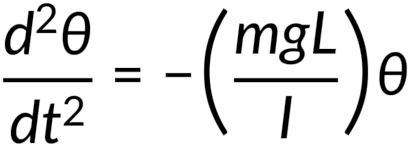15.8:
Simple Pendulum
An idealized model of a point mass suspended from a non-elastic and massless string is known as a simple pendulum.
Consider a top, freely suspended from a string fixed to a pivot point. It experiences a gravitational force and tension in the string. At the equilibrium position, both these forces balance each other.
When the top is displaced by a small angular displacement and released, it starts oscillating back and forth, executing simple harmonic motion.
The gravitational force at the displaced position is resolved into radial and tangential forces. The radial component counters the tension in the string. The restoring torque acting into the plane equals the tangential component times the string length and brings the top back to the equilibrium position.
In a simple pendulum, the restoring force is directly proportional to the displacement along the arc. By modifying the equations of simple harmonic motion, the period of a simple pendulum is obtained.
15.8:
Simple Pendulum
A simple pendulum consists of a small diameter ball suspended from a string, which has negligible mass but is strong enough to not stretch. In our daily life, pendulums have many uses, such as in clocks, on a swing set, and on a sinker on a fishing line.
The period of a simple pendulum depends on two factors: its length and the acceleration due to gravity. The period is completely independent of any other factors, such as mass or maximum displacement. For small displacements, a pendulum is identical to a simple harmonic oscillator, and the period of a pendulum is nearly independent of amplitude, especially if θ is less than approximately 15°. Applying Newton's second law for rotational systems, the equation of motion for a pendulum is obtained.

As an example, consider two simple pendulums suspended from small wires secured to the ceiling of a room. Each pendulum hovers 2 cm above the floor. Pendulum 1 has a bob with a mass of 10 kg. Pendulum 2 has a bob with a mass of 100 kg. Describe how the motion of the pendulums will differ if the bobs are both displaced by 12°.
Since the mass of the bob has no effect on the motion of a simple pendulum, the movement of the pendulums will not differ at all. A pendulum’s motion is only affected by the period (which is related to the pendulum’s length) and by the acceleration due to gravity.
This text is adapted from Openstax, College Physics, Section 16.4: The Simple Pendulum and Openstax, University Physics Volume 1, Section 15.4: Pendulums.
